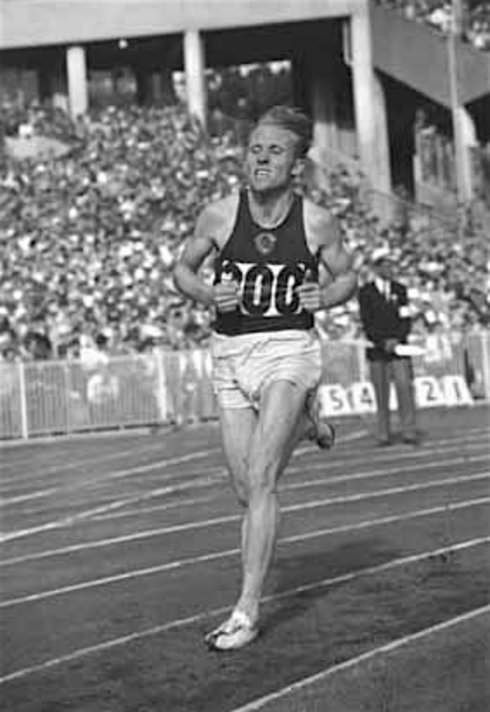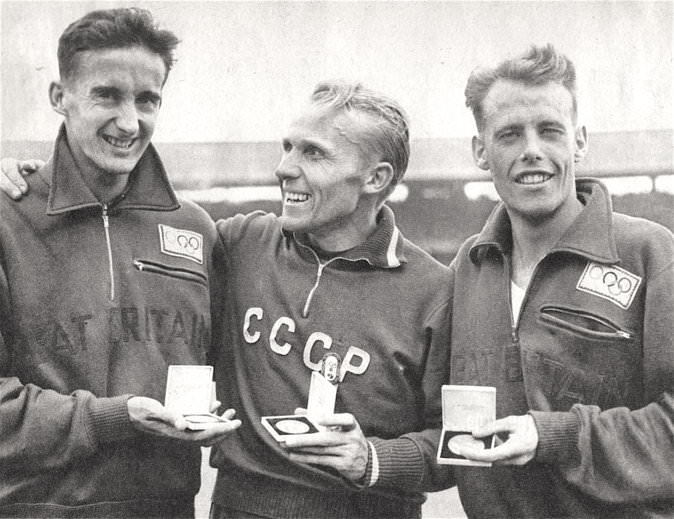PROFILE: VLADIMIR KUTS
1927-1975
(Note: Some of the available material on Kuts was clearly tainted by cold-war propaganda. Some details I’ve used might not be completely correct.)
The son of Ukraine factory workers, Kuts joined the Red Army at 16 when his town was invaded by the German army. He was on the way to artillery school when his train was bombed. He was long thought dead. When the war ended in 1945 he joined the navy and started running. Once his ability was noticed, the well-known coach Leonid Khomenkov took him under his wing.Vladimir Kuts was on the international distance-running scene for only a few years, but in those years he was the undeniable world leader. A fierce and tough competitor—like Lovelock he was also a boxer—he had nevertheless one Achilles heel: he could be beaten on the run-in. Still, he retired with two Olympic golds, a European gold and five WRs. He broke the 5,000 WR four times, improving it from 13:57.2 to 13:35.0 over three years. His 13:35 WR stood from 1957 to 1965.
After several years of hard training, Kuts burst onto the world scene in 1953, ranking 3rd in the 5,000 (14:02) and 5th in the 10,000 (29:41). The next year he set a WR to win in the Euro Championships in Bern (13:56.6), surprisingly defeating Zatopek and Chataway. But six weeks later, Chataway gained revenge for this defeat (See Great Races #10), beating Kuts in a WR time of 13:51.6, a time which Kuts beat just ten days later by 0.4 of a second. After his fine European win, Kuts teamed up with Russia’s top coach Gregory Nikiforov. This led to increasingly harder interval training and complete control of his life by Nikiforov.
The next year Kuts knocked 4.4 seconds off his 5,000 WR with 13:46.8, but later that season Iharos ran 13:40.6. In 1956 there was more record-breaking before the November Olympics in Melbourne. Briton Pirie broke the 3,000 WR twice and set a 5,000 WR of 13:36.8; Iharos of Hungary ran a 10,000 WR in 28:42,8; and Kuts ran another 10,000 WR in 28:30.4.
 |
| Melbourne Olympics: Kuts out in the lead. |
Such brilliant running set up great expectations for the Olympic 10,000 in Melbourne. Sadly, Iharos was not in the field after the Soviet invasion of Hungary, so it was a one-on-one battle between Kuts and Pirie. In another twist, Kuts nearly put himself out of the Games when he crashed an Australian car and ended up in hospital. And even earlier, just before he left for Melbourne, Kuts began to display health problems: his pulse at rest was 120, his blood pressure was high and heart murmurs were discovered. However, after a relaxing 16-day boat trip, he was pronounced fit to race.
The 10,000 (see Great Races #11) was a triumph for Kuts; he destroyed Gordon Pirie with a searing pace and a succession of surges. This victory set him up with a huge psychological advantage in his weaker race, the 5,000. Pirie admitted before the race that Kuts would “dictate the race.” However, Kuts now faced yet another problem: blood was found in his urine after the 10,000. He seriously considered opting out of the 5,000, until an official promised him a general’s pension if he ran.
Kuts led from almost the start. The first mile was slow, but Kuts then picked up the pace, passing 2 miles in 8:47 (about 13:40 pace). Pirie, Ibbotson and Chataway, his three main opponents, then let Kuts get away on his third burst, and the race was all but over. Pirie kept closing up on the Russian, but this immediately precipitated another burst. When Kuts breasted the tape at 13:39.6, Pirie was almost 100 meters behind. The Melbourne Olympics marked the highpoint of Kuts’s career. He did however have to deal with some anti-Russian sentiment; at a press conference, a woman shouting “Red rat!” emptied a bag of eight rats, all painted red, on to his table.
Kuts passed a physical examination after the Games, but he later admitted that the doctor was shocked at his condition: blue lips, ashen face and a rapid pulse. He was advised to rest. A couple of months later, he couldn’t keep up with his training companions.
In 1957, Kuts managed to recapture his 5,000 WR from Pirie with a 13:35 in Rome. After this effort he was carried off the track on a stretcher and checked into a hospital. He also ran a good 10,000 that year but was beaten by a whisker by another Russian, Pyotor Bolotnikov, 29: 09.8 to 29:10.0. By this time Kuts suffered a lot of pain and was diagnosed as having “an increased permeability of venous and lymphatic capillaries.” (T.R. Healy, “Red Star.” Toucantrackclub.net) This was said to be caused by a 1952 incident when he fell into freezing water and got frostbite.
 |
| Kuts with Pirie (left) and Ibbotsonafter the Melbourne 5,000. |
The possibility of drug use was bandied around in the West. No doubt Kuts’s health had suffered somewhat from his coach’s harsh regime. “Nikiforov seemed like an executioner,” Kuts claimed later, “determined to break me down, body and soul ... to make a warrior of me, capable of enduring any stresses of sports combat....” (Healy) But there were also stories that Kuts had used amphetamines. Zatopek thought that Kuts had used “enhancers.” He had run parts of a workout with Kuts in Melbourne before the Games and saw Kuts being given special drink solutions during the session- always prepared by his coach. “Then suddenly phhhhhhhew- he was away- speeding up from 66-68s quarters to 60-62s,” Zatopek recalled. (Letsrun.com) Pirie wrote in The People newspaper that at Melbourne “Kuts was either doped or hypnotized. I am not suggesting that Kuts, a very fine sportsman, ever accepted any form of ‘treatment’ willingly, but that he was forced to by Russian team officials.”
Kuts was warned that continuing to train at top level might kill him. Eventually he announced his retirement in 1959. After that his life went downhill. He became an alcoholic, once reputedly drinking 15 bottles of vodka in three days. The Soviet authorities ordered the press not to publish pictures of this famous man as he looked so bad. Eventually, Kuts got his drinking under control and did some coaching. He coached Afonin to break his own Russian 10,000 record. Then in August 1975, after a row with his ex-wife, he drank heavily, took some luminal pills and later died in his sleep. He was 47. It was never established if his death was an accident or suicide. 
1 Comment